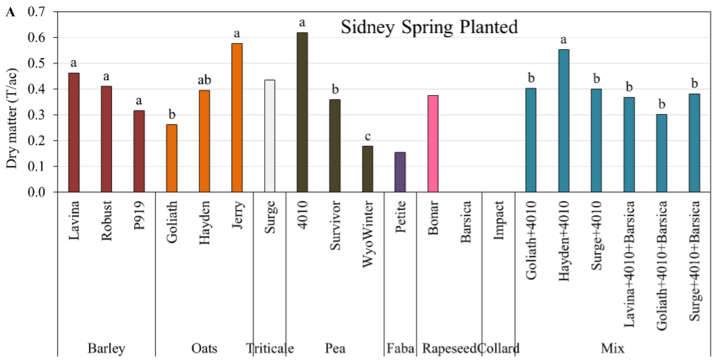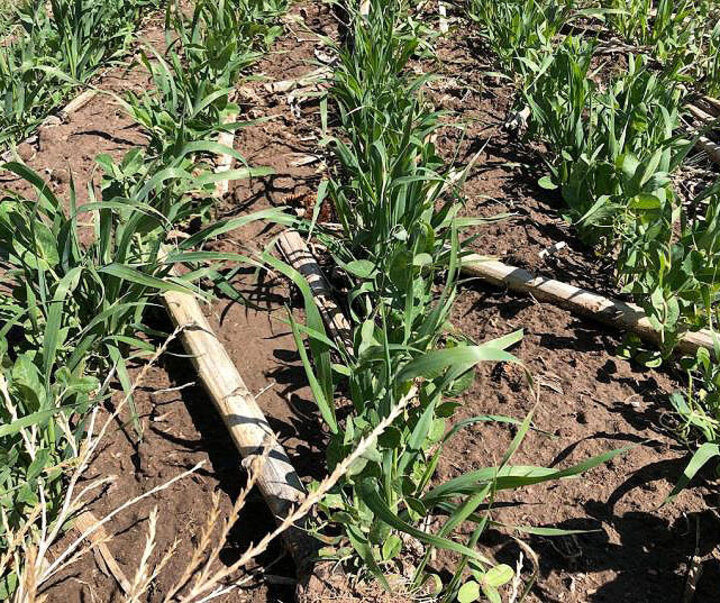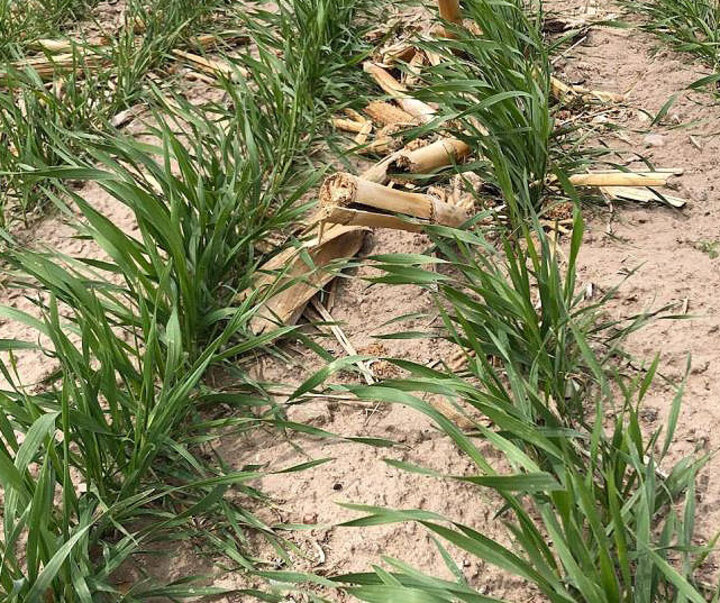Introduction
The Cover Crop Initiative is a four-year collaborative effort with the University of Nebraska-Lincoln (UNL) and Nebraska Natural Resources Conservation Service (NRCS) to learn about and promote the strategic utilization of cover crops in Nebraska. Specifically, the project establishes cover crop variety trials in multiple Nebraska ecoregions, at several UNL research stations. This project hopes to provide knowledge and skills training to NRCS, as well as other internal and external stakeholders on implementing site-specific cover crop projects designed to achieve specific management goals. Data collected will be integrated into an online portal aggregating science and experiment-based information to connect soil health and the strategic use of cover crops in Nebraska. Online information includes cover crop production estimates utilizing Nebraska-specific climate and soils information, as well as the specific information about the species selected.
Cover cropping is a widely recognized agricultural conservation practice that has been shown to improve soil health, productivity and biodiversity. It has the potential to address several issues in Nebraska, including soil erosion, nutrient management and weed suppression, as well as to serve as a cropland-livestock integration mechanism. Cover crop success, however, is dependent on the selection of appropriate cover crop species, as adaptation of different cover crop species determines its performance in achieving the specific goals of conservation and management. It is also important to note that performance differences can exist within the same species beyond environmental factors, including the specific plant hardiness zone and the local landscape.
Nebraska's annual precipitation varies greatly from west to east, ranging from 13 to 35 inches (Figure 1). This variation in precipitation, combined with the state's diverse cropping systems, soils and climate, highlights the need for a tailored approach to cover crop species selection. It is critical to select the most appropriate cover crop species or variety that is well-suited to the unique eco-region and able to achieve specific management goals, based on locally derived data and information on the species-specific capabilities and tolerances.
Cover Crop Variety Trial
The project’s cover crop variety trials are located at five UNL research stations across the state: Panhandle Research Extension and Education Center (PHREEC), Scottsbluff; High Plains Ag Lab (HPAL) near Sidney; West Central Research Extension and Education Center (WCREEC), North Platte; Rogers Memorial Farm (RMF) near Lincoln; and Haskell Ag Lab (HAL), Concord (Figure 1).
At all the project study locations, the experimental layout is a randomized complete block design (RCBD) with four replications. Cover crop planting windows are spring (March-May), summer (June-October), and fall/winter (October-April of following year). The types of cover crop species evaluated based on location and growing window are listed in Table 1. Performance of different cover crop species and varieties were evaluated by monitoring growth and other characteristics listed on Table 2.

| Site | Growing Window | Species |
|---|---|---|
| HPAL, Sidney | March 4 to May 25 | Cool-season small grains, legumes, brassicas, mixes |
| PHREEC, Scottsbluff | March 23 to May 24 | Cool-season small grains, legumes, brassicas, mixes |
| WCREEC, North Platte | June 20 to Sept. 19 | Warm-season grasses, legumes, brassicas, broadleaves, mixes |
| RMF, Lincoln | July 12 to Oct. 11 | Warm-season grasses, legumes, brassicas, broadleaves, mixes |
| HAL, Concord | Sept. 10 to spring 2023 | Cool-season small grains, legumes, brassicas, mixes |
| PHREEC, Scottsbluff | Sept. 16 to spring 2023 | Cool-season small grains, legumes, brassicas, mixes |
| WCREEC, North Platte | Sept. 30 to spring 2023 | Cool-season small grains, legumes, brassicas, mixes |
| Objective | Measurement |
|---|---|
| Establishment | Plant height and stand counts four weeks after planting (WAP) |
| Growth | Growth stages at 4 WAP |
| Biomass quantity | Dry matter at termination |
| Biomass quality (C:N ratio) | Dry matter % C and % N |
| Forage quality | NIRS analysis in fresh biomass |
| N benefits | % N in dry matter |
Adaptation and Performance Evaluation: Spring Season Cover Crops
Spring cover crops are typically short-season annual species and generally remain in the ground for about 60-90 days before cash crop planting. They are planted during the onset of spring when soil temperature is just warm enough for germination (~40℉). Spring cover crops can be planted in early March and terminated in late May, before planting cash crops like corn, dry edible beans, soybeans, barley, sugarbeets or sorghum. Spring planted cover crops provide different opportunities for species selection compared to winter cover crops.
The spring cover crops trials for 2022 were established at HPAL near Sidney and PHREEC at Scottsbluff, and planted on March 4, 2022, and March 23, 2022, respectively. Cover crops were terminated on May 24 and 25, 2022. A total of 20 species, varieties and mixes were evaluated including: grasses (seven), legumes (four), brassicas (three), two-way mixes (three), and three-way mixes (three). Species name, variety and seeding rates for all cover crop species are listed in Table 3. Site information and management details are provided in Table 4.
Table 3| Type | Species | Variety | Seeding Rate (lbs./acre) |
|---|---|---|---|
| Grasses | |||
| 1 | Spring forage barley | Lavina | 100 |
| 2 | Spring barley | Robust | 100 |
| 3 | Winter barley | P919 | 100 |
| 4 | Spring oats | Goliath | 100 |
| 5 | Spring oats | Hayden | 100 |
| 6 | Spring oats | Jerry | 100 |
| 7 | Spring triticale | Surge | 100 |
| Legumes | |||
| 8 | Spring pea | 4010 | 70 |
| 9 | Winter pea | Survivor | 70 |
| 10 | Winter pea | WyoWinter | 70 |
| 11 | Faba bean | Petite | 70 |
| Brassicas | |||
| 12 | Rapeseed | Bonar | 8 |
| 13 | Rapeseed | Barsica | 8 |
| 14 | Collard | Impact | 8 |
| Two-way mixtures | |||
| 15 | Oat + Pea | Goliath + 4010 | Each species is ½ of its full rate |
| 16 | Oat + Pea | Hayden + 4010 | " |
| 17 | Triticale + Pea | Surge + 4010 | " |
| Three-way mixtures | |||
| 18 | Barley+Pea+Rapeseed | Lavina+4010+Barsica | Each species is 1/3 of its full rate |
| 19 | Oat + Pea + Rapeseed | Goliath + 4010 + Barsica | " |
| 20 | Triticale + Pea + Rapeseed | Surge + 4010 + Barsica | " |
| Sidney | Scottsbluff | |
|---|---|---|
| Cooperator/site | HPAL/Cheyenne County | PHREEC/Scottsbluff County |
| Soil type | Keith silt loam | Tripp very fine sandy loam |
| Planting date | March 4, 2022 | March 23, 2022 |
| Seeding depth | 1 inch | 1.25 inches |
| Soil moisture at planting | Fairly dry | Adequate at seeding depth |
| Implement/tools | DCS research drill | DCS research drill |
| Rows/plot | 6 | 6 |
| Row spacing | 10 inches | 10 inches |
| Plot length | 30 feet | 30 feet |
| Alley width | 3 feet | 3 feet |
| Tillage | No-till | No-till |
| Previous crop | Sunflower | Corn |
| Pre-plant herbicide | Fall glyphosate (32 oz) | Fall glyphosate (32 oz) |
| Fertilizer at planting | None | None |
| Irrigation | Non-irrigated | Non-irrigated |
| Total precipitation during growing period | 3.7 inches | 3.9 inches |
| Termination date | May 25, 2022 | May 24, 2022 |
| Termination herbicide | Sharpen (0.6 L ha-1) Glyphosate (0.38 L ha-1) | Sharpen (0.6 L ha-1) Glyphosate (0.38 L ha-1) |
Results
Jerry oats, Pea4010 spring peas, and a mixture of Hayden oats and Pea4010 spring peas produced the highest biomass at Sidney, greater than 0.5 ton of biomass per acre (Figure 2A). There were no significant differences in biomass among cover crop varieties at Scottsbluff, although many species, including the grasses and legumes, produced approximately 0.3 tons per acre of biomass (Figure 2B). Collard (Impact) failed to establish, and Rapeseed (Barsica and Bonar) had very little growth at both Sidney and Scottsbluff (Figure 2). The three-week delay in planting reduced biomass production for most cover crop species at Scottsbluff compared to Sidney.


Conclusion
- Spring planted cover crops offer a different planting window alternative to late fall planting and can allow for successful establishment and production depending on location and growing time.
- Lavina barley, Jerry oats, Pea4010 spring pea, and a two-way mix of Hayden oats and Pea4010 spring pea performed well in terms of biomass production and establishment within the local factors experienced at these western Nebraska locations and 80-plus days of growth.
- Collard and rapeseeds did not perform or establish well within this planting window and local factors experienced at these western Nebraska locations.
- Delayed planting by three weeks at Scottsbluff reduced biomass production for most species primarily due to the decreased growing time of 62 days vs 81 growing days at Sidney, except Goliath oats with an observed greater production amount, but not with statistical confidence.






Extension and Outreach Activities
Growers are invited to visit the following sites to learn more about these cover crop variety experiments:
- Spring cover crop trials for 2023 will be repeated with the same treatment applications on new field locations at Sidney, Nebraska and Scottsbluff, Nebraska.
- Spring trials will be on display during field days on May 9, 2023, at Scottsbluff, Nebraska, and June 14, 2023, at Sidney, Nebraska.
- Fall cover crops interseeded into irrigated corn will be showcased during a field day on May 2, 2023, at Haskell Ag Lab, Concord, Nebraska.
For more project outputs, visit the CropWatch Variety Testing page.
